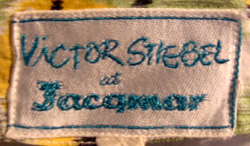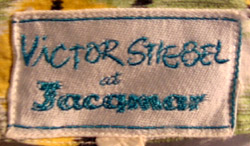(1907-1976) Victor Stiebel was one of the members of the Incorporated Society of London Fashion Designers (along with Hartnell, Amies and Molyneux) who designed Utility clothes during and immediately after WW2. He also designed Uniforms for the WRENS and WRAF. Born in Durban, South Africa, he moved to England in 1924 for his schooling and attended Cambridge University (designing costumes for their footlights revue). He was apprenticed at Reville and Rossiter in 1929 and opened his own house in 1932. The war forced the closure of his salon in 1939. He then had to design for, and under, the house of Jacqmar from 1946 until 1958, when he was able to open his own label again.
His clothes were romantic, and at times experimental with his use of stripes, plaid and pleating. He was favoured by British royalty and many actresses (Vivien Leigh being one of his most famous customers). His final collection was Summer 1963, when he closed due to poor health.
Written by emmapeelpants


